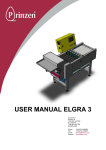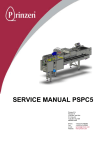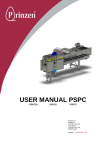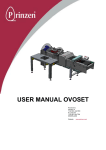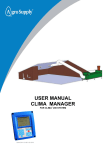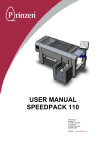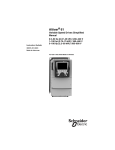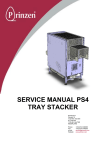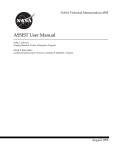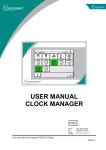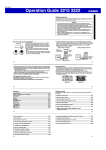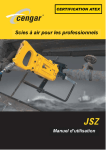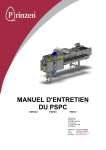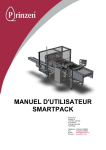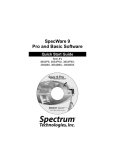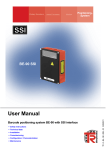Download user manual elgra 4
Transcript
USER MANUAL ELGRA 4 Prinzen B.V. Weverij 18 7122 MS AALTEN P.O. Box 85 7120 AB AALTEN NEDERLAND Phone: Fax: e mail: Website: +31(0) 543 490060 +31(0) 543 476205 [email protected] www.prinzen.com TABLE OF CONTENTS TABLE OF CONTENTS CHAPTER UM-ELGRA4-02-E/10-2008 BOOK INTRODUCTION I 1 SAFETY I 2 MACHINE DESCRIPTION I 3 OPERATION I 4 CLEANING I 5 PREVENTIVE MAINTENANCE I 6 ADJUSTMENTS I 7 SPARE PARTS I USER MANUAL ELGRA 4 Page 3 of 87 TABLE OF CONTENTS INDEX INTRODUCTION ................................................................................................................................................7 LIABILITY ............................................................................................................................................... 9 GENERAL ............................................................................................................................................... 9 COPYRIGHT ........................................................................................................................................... 9 GENERAL ............................................................................................................................................. 10 SAFETY REGULATIONS .......................................................................................................................... 10 LEGAL REGULATIONS............................................................................................................................ 10 HOW TO USE THIS MANUAL? ................................................................................................................. 11 WHO SHOULD USE THIS MANUAL? ......................................................................................................... 11 ADDRESS PRINZEN ............................................................................................................................... 11 SYMBOLS ............................................................................................................................................ 12 MANUAL INFORMATION ......................................................................................................................... 12 SERIAL NUMBER ................................................................................................................................... 12 EG-EXPLANATION OF AGREEMENT ......................................................................................................... 13 1. SAFETY..................................................................................................................................................15 GENERAL ............................................................................................................................................. 16 SAFETY REGULATIONS .......................................................................................................................... 17 SAFETY PROVISIONS ............................................................................................................................ 18 DEFINITION OF SAFETY DEVICES ............................................................................................................ 18 EMERGENCY BUTTON ........................................................................................................................... 19 SAFETY INSPECTION PROCEDURE ......................................................................................................... 19 WARNING LABELS ................................................................................................................................. 20 2. MACHINE DESCRIPTION .....................................................................................................................21 SAFETY REGULATIONS .......................................................................................................................... 22 MACHINE DESCRIPTION ........................................................................................................................ 23 ELGRA 4...................................................................................................................................................................................................... 23 POSTIONS OF SENSORS AND VALVES .......................................................................................................................................................... 26 3. OPERATION ..........................................................................................................................................27 SAFETY REGULATIONS .......................................................................................................................... 28 EXPLANATION OF THE OPERATION ......................................................................................................... 29 OPERATING PANEL...................................................................................................................................................................................... 29 STARTING THE SYSTEM .............................................................................................................................................................................. 30 STOPPING THE SYSTEM ............................................................................................................................................................................... 31 GENERAL EXPLANATION TOUCH PANEL FUNCTIONS ................................................................................ 31 MAIN SCREEN ............................................................................................................................................................................................. 32 FLOCK MENU .............................................................................................................................................................................................. 33 UNIFORMITY ............................................................................................................................................................................................... 34 FLOCK GRAPHIC.......................................................................................................................................................................................... 35 FLOCK TABLE ............................................................................................................................................................................................. 35 FLOCK SETTING MENU ................................................................................................................................................................................ 36 MANUAL REMOVED EGGS ........................................................................................................................................................................... 36 PROGRAM SELECTION ................................................................................................................................................................................. 37 PRINT RESET SCREEN .................................................................................................................................................................................. 38 WEIGHT BAND SCREEN ............................................................................................................................................................................... 39 DATE AND TIME SCREEN ............................................................................................................................................................................. 39 4. CLEANING .............................................................................................................................................41 GENERAL ............................................................................................................................................. 42 SAFETY REGULATIONS .......................................................................................................................... 42 CLEANING UTENSILS AND DETERGENTS ................................................................................................. 42 GENERAL CLEANING PROCEDURE .......................................................................................................... 43 UM-ELGRA4-02-E/10-2008 USER MANUAL ELGRA 4 Page 5 of 87 TABLE OF CONTENTS CLEANING INTERVAL ............................................................................................................................. 43 AFTER CLEANING ................................................................................................................................. 43 BEFORE CLEANING ............................................................................................................................... 44 CLEANING INSTRUCTIONS ..................................................................................................................... 46 CLEANING ROLLER TRACK ......................................................................................................................................................................... 46 CLEANING CONVEYORS .............................................................................................................................................................................. 46 CLEANING BRUSH CONVEYOR .................................................................................................................................................................... 47 CLEANING LOAD CELL EGG LANE ............................................................................................................................................................... 48 CLEANING WEIGHING UNIT......................................................................................................................................................................... 48 CLEANING DROP STATION .......................................................................................................................................................................... 49 5. PREVENTIVE MAINTENANCE .............................................................................................................51 GENERAL ............................................................................................................................................. 52 SAFETY REGULATIONS .......................................................................................................................... 52 MAINTENANCE UTENSILS ...................................................................................................................... 52 GENERAL MAINTENANCE PROCEDURE ................................................................................................... 53 AFTER MAINTENANCE ........................................................................................................................... 53 PREVENTIVE MAINTENANCE INSTRUCTIONS ............................................................................................ 54 DAILY MAINTENANCE ................................................................................................................................................................................ 54 WEEKLY MAINTENANCE ............................................................................................................................................................................. 55 MONTHLY MAINTENANCE .......................................................................................................................................................................... 56 ½ YEARLY MAINTENANCE.......................................................................................................................................................................... 58 6. ADJUSTMENTS.....................................................................................................................................59 GENERAL ............................................................................................................................................. 60 SAFETY REGULATIONS .......................................................................................................................... 60 AFTER ADJUSTMENTS ........................................................................................................................... 60 COMPONENT ADJUSTMENTS ................................................................................................................. 61 AIR SUPPLY ................................................................................................................................................................................................. 61 VALVE BLOCK............................................................................................................................................................................................. 61 INDUCTIVE PROXIMITY SWITCHES ............................................................................................................................................................. 61 OPERATION ADJUSTMENTS ................................................................................................................... 62 GATE BLOCKERS ......................................................................................................................................................................................... 62 START / STOP DELAY TIME ......................................................................................................................................................................... 62 ADJUSTMENTS ..................................................................................................................................... 63 BELT TENSION............................................................................................................................................................................................. 63 BRUSH CONVEYOR TAKE OVER RACK ........................................................................................................................................................ 63 DRIVE CHAIN TENSION ............................................................................................................................................................................... 64 DROP STATION CHAIN TENSION .................................................................................................................................................................. 64 BRUSH CONVEYOR ACCESS ........................................................................................................................................................................ 65 DROP STATION CONTROL SENSORS ............................................................................................................................................................ 65 DROP STATION CONTROL SENSORS POSITIONS ........................................................................................................................................... 66 SYNCHRONIZING DROP STATION TO ROLLER TRACK ................................................................................................................................. 67 START 0 WEIGHING..................................................................................................................................................................................... 68 START WEIGHING EGGS .............................................................................................................................................................................. 69 ST ST START DROP 1 EGG ON 1 BRUSH CONVEYOR ......................................................................................................................................... 70 ST ND START DROP 1 EGG ON 2 BRUSH CONVEYOR ......................................................................................................................................... 71 TOUCH PANEL SERVICE SCREENS.......................................................................................................... 72 SERVICE MENU 1......................................................................................................................................................................................... 72 ON/OFF SCALES SCREEN ............................................................................................................................................................................. 73 VALVE DELAY SCREEN ............................................................................................................................................................................... 74 ONLINE READ OUT ...................................................................................................................................................................................... 74 PRESSURE CONTROL ................................................................................................................................................................................... 75 UV TIMING .................................................................................................................................................................................................. 75 REJECT OUTPUT .......................................................................................................................................................................................... 76 PASSWORD SCREEN .................................................................................................................................................................................... 77 SERVICE MENU 2......................................................................................................................................................................................... 78 LOAD-CELL DATA SCREEN.......................................................................................................................................................................... 79 STATIC LOAD-CELL TEST ............................................................................................................................................................................ 79 DYNAMIC LOAD-CELL TEST ........................................................................................................................................................................ 79 LOAD-CELL RESET ...................................................................................................................................................................................... 80 CALIBRATING LOAD-CELLS ........................................................................................................................................................................ 81 FINE TUNING LOAD-CELLS.......................................................................................................................................................................... 83 RAW DATA SCREEN..................................................................................................................................................................................... 84 DIAGNOSTICS SCREEN ................................................................................................................................................................................ 84 7. SPARE PARTS ......................................................................................................................................85 Page 6 of 87 USER MANUAL ELGRA 4 UM-ELGRA4-02-E/10-2008 INTRODUCTION INTRODUCTION UM-ELGRA4-02-E/10-2008 USER MANUAL ELGRA 4 Page 7 of 87 INTRODUCTION CAUTION: This manual must be read by or to each person, before that person operates, cleans, repairs, adjusts, supervises the operation of, or uses this machine in any way. CAUCION: Este manual debe ser leido por a cada persona antes de comenzar a operar, limpiar, reparar, ajustar, supervisar la operación de, o utilizar esta maquina de cualquier manera. ATTENTION: Ce manuel doit être lu par, ou a, toute personne avant qu’elle ne mette en route, nettoie, répare, règle, supervise le fonctionnement ou utilise cette machine, de quelque manière que ce soit. VORSICHT: Jeder, der diese Maschine bedienen, reinigen, reparieren, einstellen, überwachen oder auf irgendeine Weise benutzen soll, muß vorher diese Hinweise lesen oder vorgelesen bekommen. ATTENTIE: Een ieder, die deze machine bedient, reinigt, repareert, instelt, controleert of op enige andere wijze gebruiken zal, dient vooraf deze bedieningsvoorschriften te lezen. Page 8 of 87 USER MANUAL ELGRA 4 UM-ELGRA4-02-E/10-2008 INTRODUCTION LIABILITY Prinzen BV cannot be held responsible for any costs, damage or personal injury if it’s system is not used in accordance with the instructions as described in this manual. Since Prinzen BV is constantly improving its systems it may be possible that there are small differences between your system and this manual. Though this manual has been put together with the utmost care, Prinzen BV cannot accept any responsibility for costs, damage or personal injury arising from any fault and/or incompleteness in the content of this document. GENERAL This manual contains important information concerning safety, operation, adjustment, maintenance, cleaning and repair of the Prinzen BV system. For uncomplicated functioning of the system, read this manual carefully and work according to the directions in this manual. Beside the design and the used materials also the operation and maintenance have great impact on the functioning, the life span and the operational costs of our system. You, as the owner of the system, are responsible for the execution of maintenance according to the directions and the intervals in this manual. This manual will help you to gain knowledge to use the system as it should be used: Correct operated and excellent maintained. A Prinzen BV system meets the demands, mentioned in the European machine guideline (CE). COPYRIGHT Prinzen BV © This document contains confidential information and information protected by copyright of Prinzen BV. Reproduction or transmission of any part of this document to third parties, or the use thereof is only permitted after express written permission of Prinzen BV. All rights rest with Prinzen BV, Aalten, The Netherlands. Written by Visser Machine Services. UM-ELGRA4-02-E/10-2008 USER MANUAL ELGRA 4 Page 9 of 87 INTRODUCTION GENERAL This manual contains important information concerning: - Safety - Operation - Adjustment - Maintenance - Breakdown remedies The user of the system should read and understand the total manual before operating, adjusting, maintaining and repairing the system. At all time this manual must be accessible for all personnel working with the system. Never change the sequence of procedures as described in this manual. SAFETY REGULATIONS Before starting operation, cleaning, maintaining the system or before remedying breakdowns first read this chapter and chapter Safety. LEGAL REGULATIONS - - - All safety directions stated in this manual must be observed. Along with the safety regulations in this chapter the instructions of the qualified trade organization of your country must be observed to avoid accidents. Before starting to repair or maintain the machine always consult your safety manager to discuss if a work permit is required for this job. All safety devices in the machine and the safety indications mentioned in this manual are conditions to control the machine safely. The owner and his qualified personnel are in the end the ones responsible for the safe use of the machine. The owner is responsible for the ability of the qualified personnel to perform its duties according to the safety measures. Technical changes, which influence the safety working of the machine, may only be executed by the service department of Prinzen. Do not change controls, and/or PLC programs, without written permission from Prinzen because this may affect the safety of the machine. Only use genuine Prinzen parts or CE-certified parts for replacement. Prinzen cannot be held responsible for any consequential damages to the system or other installations that were caused by technical changes, unprofessional maintenance and repairs on our system, which were executed by the customer. Warranty becomes invalid when consequential damages to the system, caused by technical changes, unprofessional maintenance and repairs, were executed by the customer. DANGER! Failure to obey legal regulations may result in permanent personal injury or death. ATTENTION! Failure to obey legal regulations may result in damage to the system. Page 10 of 87 USER MANUAL ELGRA 4 UM-ELGRA4-02-E/10-2008 INTRODUCTION HOW TO USE THIS MANUAL? The manual is constructed to provide a maximum amount of information with a minimum amount of searching. The key to easy reference is the Table of contents. Familiarize yourself with it and you won’t have any trouble locating information from any area of machine. WHO SHOULD USE THIS MANUAL? Owner: The owner (contractor, concern) is the person that owns or hires the machine and puts this machine into production. The owner must take care that the users of the system will read the manual. Operator: The operator is the person who operates the system as ordered by the owner. The operator must read the chapters Introduction, Safety, Machine description, Operation. Cleaner: The cleaner is the person who cleans the system as ordered by the owner. The cleaner must read the chapters Introduction, Safety, Machine description, Operation, Cleaning. Professional: A professional is someone who can assess the duties appointed to him on account of his education, knowledge and experience and who can assess the dangers attached, thereby avoiding these dangers. Maintenance engineer: The maintenance engineer is the professional who is deemed qualified by the owner to perform certain duties. The qualification only applies to those assigned duties. The maintenance engineer must read the total manual. ADDRESS PRINZEN Prinzen BV Weverij 18, 7122 MS AALTEN P.O. Box 85, 7120 AB AALTEN The Netherlands Telephone: Fax: E-mail: Website: +31 (0)543 490060 +31 (0)543 476205 [email protected] www.prinzen.com UM-ELGRA4-02-E/10-2008 USER MANUAL ELGRA 4 Page 11 of 87 INTRODUCTION SYMBOLS Symbols are used in the manual when special attention/caution is required while working on the system. The special symbols and their meaning are depicted in the below table. Symbol: Meaning: DANGER! This symbol is used when instructions should be followed to the letter. If not they may result in permanent personal injury or death. CAUTION! This symbol is used when instructions should be followed to the letter. If not they may result in permanent personal injury. ATTENTION! This symbol is used when instructions should be followed to the letter. If not they may cause damage to the system. NOTE! This symbol advises to use edible products and to work in a hygienically way. Disregarding this advice may cause illness. TIP! This symbol is used as a helpful hint to simplify the execution of certain tasks. MANUAL INFORMATION Machine type: Manual revision: Elgra 4 02 (October 2008) SERIAL NUMBER Each machine has a unique serial number printed on the machine tag, which can be found in the electrical cabinet. Note down this serial number to have it available when contacting the Prinzen service department. Page 12 of 87 USER MANUAL ELGRA 4 UM-ELGRA4-02-E/10-2008 EG-EXPLANATION EG-EXPLANATION OF AGREEMENT Concerning the machine standards: Prinzen B.V. Weverij 18 7122 MS AALTEN The Netherlands Declares on their responsibility: 1 We are the manufacturer of the egg packing machine: Brand: Type: Serial number: Prinzen Elgra 4 On which this agreement relates: 2 The machine is developed in agreement with the demands of the machine standard 98/37/EEG (most recent). 3 The machine meets the requirements of the demands of the following ECstandards: The low voltage standard 73/23/EEG (most recent). The EMC-standards 89/336/EEG (most recent). 4 The machine is developed and constructed according the European Standard: EN60204-1: 1993 Electrical equipment of industrial machines. Signed in: Date: Aalten Signed by: G.J. van Eerden UM-ELGRA4-02-E/10-2008 USER MANUAL ELGRA 4 Page 13 of 87 SAFETY 1. SAFETY UM-ELGRA4-02-E/10-2008 USER MANUAL ELGRA 4 Page 15 of 87 SAFETY GENERAL Only persons meeting the following requirements are authorized to work with the system. These persons should be: - Skilled and specifically trained for their duties. - Familiar with the contents of this manual. - Familiar with the locations of the emergency buttons and other safety devices. - 18 years old or above. - Familiar with the national and regional regulations regarding safety. These persons should have reached the minimum legal age required to perform this work. These persons are NOT under influence of any drug, medicine or alcoholic drink. DANGER! Keep children and incompetent persons away from the system! The system is only to be used for the purpose it was designed for. See the chapter Machine description for details. Page 16 of 87 USER MANUAL ELGRA 4 UM-ELGRA4-02-E/10-2008 SAFETY SAFETY REGULATIONS Do not use the system when safety devices have been removed. This system may contain sharp edged parts, moving parts and rotating parts. When protective covers are removed, sharp edges and pinch points may be exposed. Use extreme caution and avoid touching or striking these areas with your hands or body because they may cause injuries. Do not enter parts of your body or objects into openings in the system. This may lead to serious physical injury or damage to the system. It is dangerous to be in, on or under the system while it is operational. Loosely hanging clothing, wide sleeved clothing, ties, chains or rings are prohibited. Long hair should be worn tied back. Make sure that there is sufficient light around the machine. Do not touch or come near moving or rotating parts. Physical contact with these parts is dangerous. Do not stand or walk on any of the system parts. Do not work alone on the system. At least one other person should be present Before starting to clean, maintain or inspect the machine or before remedying breakdowns follow the steps mentioned below: - Switch off the machine and secure it against accidental switching on. - Post “Do not switch on” warning sign on the main switch: - Operate the nearest emergency button. - Make sure that no components are moving. Before switching on the machine, you must check the following: - All safety devices are in place and are functioning. - No other persons are in, underneath or above the system. - No tools or objects are in the system. - No other persons are at risk. Do not use water to clean electricity cabinets and other electronic components. For save and easy operation keep the area and floor around the machine clean, free of oil, grease or obstacles. Remove superfluous fat and greasing oil after greasing duties. When an extension cable is used for power supply, make sure that the cable diameter in relation to the length of the cable is correct. Make sure the cable is completely unrolled Manual activation of safety switches is forbidden. When the safety devices are put out of operation, the machine must first be switched off and secured against accidental switching on. DANGER! Failure to obey safety regulations may result in permanent personal injury or death. ATTENTION! Failure to obey safety regulations may result in damage to the system. UM-ELGRA4-02-E/10-2008 USER MANUAL ELGRA 4 Page 17 of 87 SAFETY SAFETY PROVISIONS 1 1 Before operating the machine the safety devices must be checked for correct functioning. Also the protective covers must be mounted before starting to use the system. Repair or replace safety devices before using the system if they do not work properly. Never rely solely on safety devices. Always switch off the system and lock up the power source (1) before working on the machine. DANGER! Protective covers safeguard dangerous machine areas. These covers are of utmost importance to operate the machine safely. Never operate the machine when protective covers are removed because serious injury or death may occur! 2 2 DEFINITION OF SAFETY DEVICES 3 Safety devices are: lockable doors (2), emergency buttons (3), safety switches (4) and protective covers (5). 4 5 5 The emergency button prevents the machine from operating and should stop the machine immediately when it is pressed. Safety switches are provided to prevent the operation of the machine or should stop the machine immediately when a door is opened. Protective covers shield off dangerous moving parts. These covers cannot be removed without tools. Lockable doors are doors that can only be opened with a key. The key should only be in possession of a supervisor. DANGER! Lockable doors safeguard dangerous machine areas. These doors are of utmost importance to operate the machine safely. Never operate the machine when doors are open or not locked because serious injury or death may occur! Page 18 of 87 USER MANUAL ELGRA 4 UM-ELGRA4-02-E/10-2008 SAFETY EMERGENCY BUTTON To stop the machine in case of an emergency, the system has one or more emergency buttons. Only use the emergency button in case of an emergency. When the emergency button is pressed, the system stops immediately. The button stays mechanically locked so the machine cannot start until it is considered safe to do so. Release the emergency button by turning it clockwise. Do not release the emergency button when it is not certain why and by whom it was pressed. Personnel working with the system must know the positions of the emergency buttons. SAFETY INSPECTION PROCEDURE Before starting the machine all protective covers must be in place, all doors must be closed and safety switches and emergency buttons must be operating. Trained personnel must check safety devices to assure proper operation. 1) Check that all protective covers are in place and all doors are closed. 2) Start and stop the system. 3) Wait until the system has completely stopped and open a door. 4) Push the start button, the machine should not start. 5) Close the door. 6) Repeat the above steps 3, 4 and 5 for each door. 7) Make sure that the machine does not start with a door opened. 8) Check that all doors are closed and push an emergency button 9) Push the start button, the machine should not start. 10) Pull the emergency button. 11) Repeat the above steps 8, 9 and 10 for all emergency buttons. 12) Make sure that the machine does not start when any emergency button is pressed. If the machine operates with any of the doors opened or when an emergency button is pressed, this machine is not safe to operate. Immediately call a qualified technician to repair the defective safety switch or emergency button. UM-ELGRA4-02-E/10-2008 USER MANUAL ELGRA 4 Page 19 of 87 SAFETY WARNING LABELS The Prinzen system makes dangerous movements. The system also contains dangerous parts when they contact the body. The following labels are posted as a warning. Understand and remember the meaning of the warning labels. DANGER! Keep the warning labels clean. When labels become unclear, replace them. The flashlight label is used to warn for dangerous voltage inside a cabinet. Contacting parts inside this cabinet may result in permanent personal injury or death. This sign is used to warn for dangerous movements. Keep a safe distance to those parts. Disregarding this warning may result in permanent personal injury. This sign is used to warn for the danger of limbs being pulled in. Keep a safe distance to those parts. Disregarding this warning may result in permanent personal injury. This sign is used to warn for crushing danger. Keep a safe distance to those parts. Disregarding this warning may result in permanent personal injury. Page 20 of 87 USER MANUAL ELGRA 4 UM-ELGRA4-02-E/10-2008 MACHINE DESCRIPTION 2. MACHINE DESCRIPTION UM-ELGRA4-02-E/10-2008 USER MANUAL ELGRA 4 Page 21 of 87 MACHINE DESCRIPTION SAFETY REGULATIONS Before starting operation, cleaning, maintaining the system or before remedying breakdowns first read the chapters Introduction and Safety. Page 22 of 87 USER MANUAL ELGRA 4 UM-ELGRA4-02-E/10-2008 MACHINE DESCRIPTION MACHINE DESCRIPTION ELGRA 4 1 9 2 3 8 4 5 6 7 Use: The Elgra 4 is used to electronically weigh eggs and separate these eggs into 4 user-defined sizes. Construction: The Elgra 4 consists of: 1 Infeed conveyor 2 Infeed gates 3 Roller track 4 Weighing unit 5 Drop station. 6 Brush conveyors (2x) 7 Optional manual packing station. 8 Optional Candling unit / UV-unit. 9 Main electrical panel and operating panel The layout of the Elgra is adaptable to the positions of the upstream an downstream equipments by changing the position of the infeed conveyor, the brush conveyors and the manual packing station in relation to the drop station. The above picture is just an example. When the Candling unit and/or the UV unit are implemented in the Elgra 4, probably the infeed part is extended. The main electrical panel may be positioned on one of the sides of the roller track, but it may also be positioned in the frame of upstream or downstream systems Process: Eggs are entering the Elgra 4 on the infeed conveyor. On this belt, oversized, misshapen-, cracked- or dirty eggs should be manually removed. Egg pressure control switches on the sides of the infeed conveyor prevent accumulation of eggs on the infeed conveyor. The eggs run through the infeed gates onto the roller track (3) in between 2 rollers on roller shafts. Because of the shape of the rollers and their rotating movement the eggs are positioned flat in between the rollers at the end of the roller track. Here the eggs are transferred via star-wheels onto an egg lane and are guided towards load-cells by elevator shafts. On the load-cells the eggs are UM-ELGRA4-02-E/10-2008 USER MANUAL ELGRA 4 Page 23 of 87 MACHINE DESCRIPTION weighted. During the following transport of the eggs towards one of the brush conveyors, or the packing table, the eggs are tracked for controlling their correct destination depending on their weight. After weighing, the elevator shafts move the eggs upwards through the drop station where the eggs are transported above 2 brush conveyors. At the end of the drop station normally a manual packing station is positioned. In the drop station, above the brush conveyors, small openings with hinged hatches are able to drop the egg onto one of the brush conveyors. When all hatches remain closed the eggs are transported onto the manual packing station. Instead of this manual packing station it is also possible to place a conveyor or a packer (PSPC) at this position for further transport of the eggs. The brush conveyor consists of a conveyor with the actual brushes that receives the eggs from the drop station, a rotating brush and an outfeed conveyor. It is possible to connect a packer (PSPC), a packing table or another conveyor to the brush conveyor for further transport of the eggs. The operator defines which egg sizes are transported to which outfeed direction by defining 2 weight classes (weight class 1 and weight class 2). Beside these weight classes there is a weight class above both weight classes (weight class +big) and below both weight classes (weight class –small). Depending on the configuration of the Elgra 4 and its program, the eggs of the different weight classes are separated and transferred to the 3 outfeed stations. Operation: There is one operating panel on the Elgra 4, situated close to the roller track built into an electrical cabinet. See the chapter operation for operation details and the electrical drawings for electrical details. Security: The security of the system is created through a balance between safety and workability: An optimal workable situation is created for the operating personnel but safety was kept in mind. Perilous movements of the system are mostly protected with protective covers or safety doors, but there are exceptions. On a lot of places in the system it is possible to sustain injuries. The conveyors, the roller track and the infeed- and outfeed of the drop station are not completely secured with protective covers. Therefore be cautious with loosely hanging clothes and long hair, do not come too close to the conveyors, the roller track and the drop station and do not touch them when the system is running production. CAUTION! Do not enter objects or body parts into the conveyors or roller track when the system is running production. ATTENTION! Do not enter objects or body parts into the conveyors or roller track when the system is running production. ATTENTION! A force of more than 3 kilo’s damages the load-cells in the weighing unit. Never put any force or pressure on the load-cells! Page 24 of 87 USER MANUAL ELGRA 4 UM-ELGRA4-02-E/10-2008 MACHINE DESCRIPTION Restrictions: Eggs heavier than 99,99 grams are not used for calculating the average weight. Eggs longer than 76 mm or wider than 52 mm cannot run through the system and should be manually removed from the infeed conveyor. Also dirty eggs and eggs with cracks should be removed from the infeed conveyor. Specifications: Resolution: Accuracy: Maximum Flocks: Maximum amount of eggs per flock: Maximum amount of total eggs: Maximum egg mass: Maximum speed: 0,1 grams. 0,3 grams absolute. 8 65.525 524.280 9999 kg (140.000 eggs of 70 grams) 20.000 eggs/hour TIP! When the maximum permitted data is reached, reset the performance data. Otherwise performance data on touchpanel and ticket are incorrect! Electrical data: Connection voltage Pre fuse Maximum current Power Maximum voltage deviation Other possible connections Pneumatic data: Air consumption Air pressure : : : : : : 400V 3 phase + N + PE 50Hz 16 Amp, slow blowing 3 Amp 1.5 kW -6% to +10%. 1 phase is possible on request. 60 Hz is possible on request. : 20 normal Liter/minute : in between 8 and 10 bars (System air regulator reduces it to 6 bars) The climate around the machine must have a normal working temperature (+10ºC to 30ºC). Environment consequences: Dismantling and disposal of the system must be carried out by a suitable disposal company, which has the required licenses and permits for the state or the country concerned. Dismantled materials should be sorted for disposal according to local rules and regulations that may apply. Separate all materials like oil and lubrication fluids and discharge them as chemical waste. UM-ELGRA4-02-E/10-2008 USER MANUAL ELGRA 4 Page 25 of 87 MACHINE DESCRIPTION POSTIONS OF SENSORS AND VALVES Page 26 of 87 USER MANUAL ELGRA 4 UM-ELGRA4-02-E/10-2008 OPERATION 3. OPERATION UM-ELGRA4-02-E/10-2008 USER MANUAL ELGRA 4 Page 27 of 87 OPERATION SAFETY REGULATIONS Before starting operation, cleaning, maintaining the system or before remedying breakdowns first read the chapters Introduction and Safety. Page 28 of 87 USER MANUAL ELGRA 4 UM-ELGRA4-02-E/10-2008 OPERATION EXPLANATION OF THE OPERATION OPERATING PANEL Emergency stop: After pushing the red button, the complete system stops. Rotate the red button to release the emergency stop. It may be possible that the emergency button of the Elgra is combined with other emergency buttons of the upstream and downstream systems, like for example a downstream PSPC. TIP! Only use the emergency button for real emergencies. Follow the normal stop procedure to stop the system. TIP 0 AUTO: With this selector switch it is possible to switch the Elgra ON (AUTO) or OFF (0). Beside this it is possible to manually control movements of the Elgra by activating the TIP or INCH button. UV: With this optional selector switch it is possible to switch the optional UV lights ON (1) or OFF (0). When Elgra is switched OFF, the UV lights will also switch OFF automatically. Candling: With this optional selector switch it is possible to switch the optional candling lights ON (1) or OFF (0). DANGER! Although a lot of safety measures are built into the control of the system, Prinzen cannot guarantee that no dangerous situations will occur. Before you start the system, make sure no persons are in danger. ATTENTION! By working on a higher operating level, you have the possibilities to change parameter settings. This may result in malfunctioning and even damage of the system. Touchpanel: By pressing on certain parts of the touchpanel, depending on the chosen button or screen, the system is controllable, process settings can be changed or information becomes visible on the screen. Ticket Printer: The ticket printer is used to print the day results (performance of a flock) after the print day results button is touched in the print reset screen on the touchpanel. ATTENTION! It is not necessary to press real hard on the Touch Panel. We advise against doing this because it may damage the Touch Panel. It is forbidden to press on the Touch Panel with (sharp) objects because this may also damage the Touch Panel. UM-ELGRA4-02-E/10-2008 USER MANUAL ELGRA 4 Page 29 of 87 OPERATION STARTING THE SYSTEM Follow below steps to start up the system: 2 9 8 ATTENTION! Before starting the system make sure maintenance is performed according to the maintenance instructions further on in this manual. 1. Close all security doors. 2. Switch the system ON. It takes at least 10 seconds before it is possible to start the Elgra. TIP! It is assumed that the Elgra is combined with a PSPC. 5 4 3. Press the reset button on the PSPC (see PSPC user manual for starting the PSPC). 4. Go to the reset counters screen and reset all the counters. 5. Go to the flock-setting menu and enter flock number of the flock from which the eggs will be collected. 6. Select the appropriate program for the correct destination of the eggs. TIP! Without selecting a program, all eggs are transferred to the manual packing station. Always select a program after the system has been powered down. 5 7. Check the weight band. 8. In case of a UV unit and/or a candling unit present, switch those units ON. 9. Switch the Elgra selector switch ON. 10. Now the system is started. When the Elgra is used as a stand-alone system it is running now. When the Elgra is combined with a PSPC, the Elgra starts when the PSPC is started. 6 TIP! When the Elgra is combined with a downstream PSPC system, starting and stopping of the Elgra is controlled by the PSPC. When the PSPC stops for whatever reason (pressure control switches), also the Elgra stops. 7 Page 30 of 87 USER MANUAL ELGRA 4 UM-ELGRA4-02-E/10-2008 OPERATION STOPPING THE SYSTEM Follow below steps to stop the system: 8 3 5 1. First wait until no more eggs are supplied on the infeed conveyor. 2. Wait until all eggs are transported out of the Elgra onto downstream systems. No more eggs should be present inside the system. 3. Switch the Elgra selector switch OFF. 4. Wait until all movements of the system are stopped. 5. Go to the flock-setting menu and enter flock number of the flock from which you want to print the performance data. 6. Enter the amount of manually removed eggs (eggs with double yolks, eggs with cracks and dirty eggs). 7. Go to the print data screen and print the performance data of the selected flock on a ticket. 8. Switch the system OFF. GENERAL EXPLANATION TOUCH PANEL FUNCTIONS 6 Some buttons appear on a lot of screens. These buttons are for example: Back to previous menu, thumb wheel switch for entering values….. These buttons are only explained once, on the first pages of this chapter. Because of this it is wise to read the first pages carefully. With a few buttons, it is possible that parts start to move after touching these buttons. Take note that the control unit may overrule normal safeties when you touch these buttons. 7 DANGER! Before you start to move parts of the system manually, make sure no persons are in danger. ATTENTION! When you move parts manually, it may be possible that parts will collide, resulting in damage of the system. UM-ELGRA4-02-E/10-2008 USER MANUAL ELGRA 4 Page 31 of 87 OPERATION MAIN SCREEN As soon as the main switch is turned ON, the main screen appears. 2 3 4 5 1 Following information is visible on the main screen: Date: The current date is printed here. Flock: Here the flock from which the eggs are currently running through the Elgra is printed here. Amount: The amount of eggs the Elgra has weighted after the last reset is printed here. Average: The average weight of all eggs weighted after the last reset is printed here. Flock menu (1): By pressing this button it is possible to enter the flock menu in which it is possible to view the performance of a certain flock. Here it is also possible to select a certain flock from which the eggs are going to run through the Elgra. Service menu (2): After pressing this button the service menu appears. In this menu it is possible to change parameter settings of the system. See chapter adjustments for detailed explanation of the service menu screens. Print / reset menu (3): After touching this button the print / reset screen appears. In this screen it is possible to print the flock results (performance of a flock) on the ticket printer. It is also possible to reset all data here. Weight band menu (4): By touching this button the weight band screen appears. In this menu it is possible to enter the weight bands of the eggs. This determines the destination of the eggs (brush conveyor 1, brush conveyor 2 or manual packing station. Clock menu (5): After touching this button you enter the date and time screen in which it is possible to set the correct date and time. Page 32 of 87 USER MANUAL ELGRA 4 UM-ELGRA4-02-E/10-2008 OPERATION FLOCK MENU 1 2 3 4 TIP! When the maximum permitted data is reached, reset the performance data. Otherwise performance data in the flock menu is incorrect! The following detailed information for a selected flock is visible in the flock menu: Total: The average weight of all weighted eggs followed by the total produced eggs. =Class1: The average weight of all eggs, which fall within the preset, Lower and Middle limit followed by the number of eggs falling within this weight band. =Class2: The average weight of all eggs which fall within the preset Middle and Upper limit followed by the number of eggs falling within this weight band. -Small: Number of eggs weighing less than the lower limit. These eggs are transferred to the manual packing station. +Big: Number of eggs weighing more than the Upper limit. These eggs are transferred to the manual packing station. Lower limit, Middle limit, Upper limit: The set points for the Lower, Middle and Upper limits. Uniformity: The percentage of eggs which fall within a bandwidth of + and –10% towards the total amount of eggs. See uniformity explanation on next page. Flock graphic (1): After touching this button you will enter the flock graphic menu, which visualizes the uniformity of the collected eggs. Flock table (2): After touching this button you will enter the flock table menu, which gives the exact weight information of the collected eggs. Flock setting menu (3): In the Flock setting menu it is possible to select the flock from which the eggs have to run through the Elgra. Beside this, per flock it is possible to enter the manually removed eggs before entering the Elgra. Back to previous menu (4): After touching this button you will return to the previous menu. UM-ELGRA4-02-E/10-2008 USER MANUAL ELGRA 4 Page 33 of 87 OPERATION UNIFORMITY The alongside picture is an example of the collected eggs of a certain flock. In this example 2865 eggs are collected with an average weight of 60,85 grams. 288 eggs fall within 60 and 61 grams, 269 eggs fall within 61and 62 grams, etcetera. The controller determines 47 weight areas. Around each area it creates a weight band of + and – 10%. For example 10% of 45 grams is 4,50 grams. The weight band around the 45 grams area is from (45-4,5=) 40,50 grams to (45+4,5=) 49,50 grams. Each egg with a weight in between 40,50 grams and 49,50 grams is placed in the 45 grams weight area. In the alongside table all 2865 collected eggs are placed in the several weight areas. In this example the weight area with the highest score is the 60 grams area (weight of the eggs in between 54 and 66 grams) with 2544 eggs. The uniformity definition: The percentage of eggs which fall within a bandwidth of + and –10% towards the total amount of eggs. In the example 2544 eggs of the total of 2865 collected eggs fall within this bandwidth of + and – 10%. The uniformity = (2544/2865)x100% = 88,7% Page 34 of 87 USER MANUAL ELGRA 4 UM-ELGRA4-02-E/10-2008 OPERATION FLOCK GRAPHIC The graphic shows the amount of eggs per weight class, which visualizes the uniformity of eggs collected from the particular flock (since the last reset). Max (1): Here the number of eggs in the weight class with the highest count is printed. 1 FLOCK TABLE Here the exact amount of eggs per weight class is printed. 2 UM-ELGRA4-02-E/10-2008 Next (2): By pushing the next button, the next classes appear on the screen. USER MANUAL ELGRA 4 Page 35 of 87 OPERATION FLOCK SETTING MENU 3 2 1 Flock number (1): With the – or + button it is possible to decrease or increase the displayed number. The displayed number represents a certain flock. When you want to collect eggs from a particular flock through the Elgra, enter the flock number in this screen and confirm this with the back to previous menu button. Manual removed eggs (2): After touching this button you enter the manual removed eggs screen. In this screen it is possible to enter all the eggs that are manually removed on the infeed belt. Program (3): After touching this button you enter the program selection screen. In this screen you can select a program. The selected program determines which eggs are transferred to which brush conveyor. MANUAL REMOVED EGGS With the – or + buttons it is possible to enter the amount of eggs with double yolks, dirty eggs and eggs with a crack, which have been removed form the infeed belt before entering the Elgra. The entered data in this menu is added to the automatically counted eggs and is used for calculating the performance of the particular flock. Page 36 of 87 USER MANUAL ELGRA 4 UM-ELGRA4-02-E/10-2008 OPERATION PROGRAM SELECTION Here you can select a certain program. It is necessary to select a program after a power down of the system. When no program is selected all eggs are transferred to the manual packing station. The program possibilities are defined in the controller by the Prinzen software engineer. Each Elgra can have unique program possibilities. The alongside program selection screen is just an example of the possible available programs: Program 1 = C2---C1---B/S: Eggs which fall within the middle and upper limit (Class 2) are transferred to brush conveyor 1, Eggs which fall within the lower and the middle limit (Class 1) are transferred to brush conveyor 2. Eggs weighing more than the upper limit (Big) or less than the lower limit (Small) are transferred to the manual packing station. Program 2 = C1---C2---B/S: Eggs which fall within the lower and the middle limit (Class 1) are transferred to brush conveyor 1, Eggs which fall within the middle and the upper limit (Class 2) are transferred to brush conveyor 2. Eggs weighing more than the upper limit (Big) or less than the lower limit (Small) are transferred to the manual packing station. Program 3 = ½---½---B/S: All eggs within the lower and the upper limit (Class 1 and Class 2) are transferred to brush conveyor 1 and brush conveyor 2. Each brush conveyor receives half of the amount of eggs. Eggs weighing more than the upper limit (Big) or less than the lower limit (Small) are transferred to the manual packing station. UM-ELGRA4-02-E/10-2008 USER MANUAL ELGRA 4 Page 37 of 87 OPERATION PRINT RESET SCREEN Reset: After touching the reset button all performance data of all flocks will be deleted. Before deleting all the data, a message screen pops up. Confirm by touching the reset button. All data is deleted. By touching the back to previous menu button, the data is not deleted. TIP! When the maximum permitted data is reached, reset the performance data. Otherwise performance data on the ticket is incorrect! Page 38 of 87 Print: After touching the print button, all performance data of the selected flock (since the last reset) is printed on the ticket printer: Flock no: Selected flock for printing performance data. Date: Date during printing. AV Weight: Average weight off all the eggs, which passed the load-cells. Amount: Total amount of eggs including the manually removed eggs (double yolks, dirty and cracked eggs). Egg mass: Total weight of all eggs, which passed the load-cells Uniformity: The calculated uniformity, see uniformity for explanation. Hatch eggs: All eggs falling in between the upper and lower weight limit. Followed by the average weight of these hatch eggs. Class 1 eggs: All eggs falling in between the lower and middle weight limit. Class 2 eggs: All eggs falling in between the middle and the upper weight limit. Small: All eggs smaller than the lower weight limit. Big: All eggs bigger than the upper weight limit. Double yolks: The amount of manual removed eggs with double yolks. Followed by the percentage of these eggs in relation to the total amount of eggs. Dirt/crack: The amount of manual removed dirty and cracked eggs. Hatch percentage: The amount of eggs falling in between the upper and lower weight limit in relation to the total amount of eggs. USER MANUAL ELGRA 4 UM-ELGRA4-02-E/10-2008 OPERATION WEIGHT BAND SCREEN Here it is possible to set the weight band of the eggs, which determines the destination of the eggs (brush conveyor 1, brush conveyor 2 or manual packing station. Class1: Enter the lower weight limit in the top. Enter the middle weight limit in the bottom. When eggs have a weight in between these both limits, it is assigned to class 1. Depending on the selected program, these eggs are transferred to a certain output Class2: Enter the upper weight limit. When eggs have a weight in between the middle weight limit and this upper weight limit, it is assigned to class 2. Depending on the selected program, these eggs are transferred to a certain output. TIP! Always enter the lowest value in Class 1, the middle value in the left bottom corner and the highest value in Class 2. Otherwise all eggs are transferred to the manual packing station. DATE AND TIME SCREEN Here the current date and time is printed. To change this date or time, touch the change button. With the – or + buttons it is possible to change the date setting or time setting. To be able to change the date and time, first all fields have to be set to the correct date and time. After this, touch the SET button to make the set date and time the current date and time. By touching the back to main menu button without first touching the SET button, the date and time remains unchanged. UM-ELGRA4-02-E/10-2008 USER MANUAL ELGRA 4 Page 39 of 87 CLEANING 4. CLEANING UM-ELGRA4-02-E/10-2008 USER MANUAL ELGRA 4 Page 41 of 87 CLEANING GENERAL Cleaning personnel who are familiar with the installation may only perform cleaning duties. When during cleaning duties questions arise regarding the condition of the system, consult your maintenance engineer. SAFETY REGULATIONS Read the chapters Introduction and Safety before starting operation, cleaning, maintaining the system or remedying breakdowns. CLEANING UTENSILS AND DETERGENTS In general we advise to have the following tools, cleaning utensils and detergents available during cleaning duties: - Padlock. - Vacuum cleaner. - Compressed air. - Plastic scraper. - Moistened cloth. - Water and neutral soap. - Lubricants. CAUTION! When using warm water to moisten a cloth, make sure the temperature of the water is below 45°C. Above this temperature it is possible to incinerate body parts. ATTENTION! Do not use abrasive cleaning detergents or utensils on non-longwearing parts. ATTENTION! Do not use aggressive cleaning products. Use cleaning product with a PH value between 6 and 8. After cleaning with a cleaning product, rinse off with plenty of water. ATTENTION! The system is NOT designed for wet cleaning. Do NOT clean the system with water and certainly NOT with a high spraying pistol. Only use moistened cloths for cleaning. Do NOT clean bearings, printers, robots, electrical parts and pneumatic parts with water. NOTE! Use H1 classified lubricants. These lubricants are approved to use in the food processing industry. TIP! Prinzen uses Interflon Fin Food Lube Teflon spray. Page 42 of 87 USER MANUAL ELGRA 4 UM-ELGRA4-02-E/10-2008 CLEANING GENERAL CLEANING PROCEDURE Read the below general cleaning procedure to clean the system. For specific cleaning instructions see the cleaning instructions further on in this chapter. - See to it that all eggs and trays are removed by letting the machine run empty. Switch off the system and secure it against accidental switching on. Clean the complete system with a vacuum cleaner, compressed air, a dry cloth and a plastic scraper. Remove persisting scrap with a moistened cloth. Check the condition of the cleaned parts during cleaning. CLEANING INTERVAL Remove all dirt inside and around the system after every 8 hours running production. Clean the system thoroughly after every 40 hours running production and afterwards lubricate the moving parts according to the preventive maintenance instructions further on in this manual. TIP! The cleaning advices and cleaning intervals described in this manual are general. For your specific products and production process the cleaning schedule may need alteration. During the first production months observe the contamination of the system and the influence of this contamination on the product quality and production process and (if necessary) change the cleaning methods and schedules. AFTER CLEANING When the cleaning duties are finished, follow steps below: - Consult your maintenance engineer in case of questions about the condition of parts. Lubricate moving parts that have been cleaned. Remove excess grease after lubrication. Make sure all cleaning utensils are removed from the machine. The system must be absolutely dry before putting it back into operation. UM-ELGRA4-02-E/10-2008 USER MANUAL ELGRA 4 Page 43 of 87 CLEANING BEFORE CLEANING For easy cleaning of the brush conveyor, the load-cell egg lanes and the drop station, the drop station must be placed in the up position. Follow the below procedure to move the drop station upwards: 3 CAUTION! Be careful during upward or downward movement of the drop station. It is heavy. Lift it up or down with 2 persons. Do not drop it. Make sure no persons are in danger during upward or downward movement. 1 Drop station upward procedure: 1. Loosen both knurled knobs and remove the gearwheels cover. 2. Put a mark on the drop station gearwheel and the intermediate gearwheel. 2 TIP! The drop station and the roller track are driven by 1 motor. Since the positions of the elevator shafts (drop station gearwheel) are synchronized with the positions of the roller track (intermediate gearwheel), after cleaning both gearwheels must connect into the same gear. 3 3. On both sides of the drop station, place the handle onto the lever construction. 4. With 2 persons, each on one side of the drop station holding the handle, simultaneously lift up the drop station. When the upward movement is not simultaneously the drop station tilts. 3 4 Page 44 of 87 USER MANUAL ELGRA 4 UM-ELGRA4-02-E/10-2008 CLEANING 5. When the drop station is completely up, lock the lever construction on both sides of the drop station! CAUTION! Make sure the drop station is locked on both sides before lowering and removing the handles. Make sure no body is in danger! Never release the locks without the handles holding the lever construction. 6. Do not leave the drop station unattended when it is in the upward position! 5 5 CAUTION! Be careful during upward or downward movement of the drop station. It is heavy. Lift it up or down with 2 persons. Do not drop it. Make sure no persons are in danger during upward or downward movement. 1 Drop station downward procedure: 1. On both sides of the drop station, place the handle onto the lever construction. 2. With 2 persons, each on one side of the drop station holding the handle Loosen the locks to release the drop station. 3. Simultaneously lower the drop station. When the downward movement is not simultaneously the drop station tilts. 4. Make sure the mark on the drop station gearwheel is exactly on the same position as the mark on the intermediate wheel. 5. Remove the mark. 1 TIP! To prevent confusion during the next cleaning duty, remove the mark. 2 2 6. Place the cover around the gearwheels and lock it with the knurled knobs. 4 3 UM-ELGRA4-02-E/10-2008 USER MANUAL ELGRA 4 Page 45 of 87 CLEANING CLEANING INSTRUCTIONS 1 2 CLEANING ROLLER TRACK Use compressed air to clean the roller track (1). Remove persisting scrap with a moistened cloth. CLEANING CONVEYORS Clean the conveyors (2) with a plastic scraper and a moistened cloth or brush. 2 Remove the waste bin (3) from underneath the infeed gates and clean it with water. 3 Page 46 of 87 USER MANUAL ELGRA 4 UM-ELGRA4-02-E/10-2008 CLEANING CLEANING BRUSH CONVEYOR 4 For easy cleaning of the brush conveyor first move the drop station up. Use compressed air to clean the brushes from the brush conveyor (4), the take over rack (5) and the rolling brush (6). Remove persisting scrap with water. Remove the 2 waste bins (7) from underneath the brush conveyors and clean them with water. 6 5 7 UM-ELGRA4-02-E/10-2008 USER MANUAL ELGRA 4 Page 47 of 87 CLEANING CLEANING LOAD CELL EGG LANE For easy cleaning of egg lanes first move the drop station up. Use compressed air to clean the egg lane (6). Remove persisting scrap with a moistened cloth. Do not put any force or pressure on the weighing heads (7). 6 7 ATTENTION! A force of more than 3 kilo’s damages the loadcell underneath the weighing head. Never put any force or pressure on the weighing heads! CLEANING WEIGHING UNIT 11 10 12 For easy cleaning of the weighing unit, it is possible to slide this unit to the side out of the system. For this, the drop station has to be in the down position. First loosen the 2 knurled knobs (10) and remove the cover (11). Now lift the locking strip (12) and carefully pull the weighing unit out of the system (13). Use compressed air and a plastic scraper to clean the weighing unit (13). Remove persisting scrap with a moistened cloth. Do not put any force or pressure on the weighing heads (14). Especially check the area underneath the weighing head (15). When egg yolk accumulates underneath it, this may malfunction the correct weighing of eggs. Remove egg yolk underneath the weighing heads every 8 hours. 14 13 ATTENTION! A force of more than 3 kilo’s damages the loadcell underneath the weighing head. Never put any force or pressure on the weighing heads! ATTENTION! Aggressive cleaning products will damage the load-cells. Try to clean the weighing unit with compressed air and a plastic scraper. When wet cleaning is necessary, only use a moistened cloth without a cleaning product. 15 Page 48 of 87 USER MANUAL ELGRA 4 UM-ELGRA4-02-E/10-2008 CLEANING CLEANING DROP STATION For easy cleaning of drop station first move it up. Use compressed air to clean the egg lanes (20), the hatches (21) and the elevator shafts (22) Remove persisting scrap with a moistened cloth. 22 20 21 UM-ELGRA4-02-E/10-2008 20 USER MANUAL ELGRA 4 Page 49 of 87 PREVENTIVE MAINTENANCE 5. PREVENTIVE MAINTENANCE UM-ELGRA4-02-E/10-2008 USER MANUAL ELGRA 4 Page 51 of 87 PREVENTIVE MAINTENANCE GENERAL Only professionals who are familiar with the installation and its operation may perform maintenance, repairs and replacement of defective or worn out parts. In case of difficult or special repairs consult the Service Department of Prinzen. Inspections must be carried out before, during and after operation of the machine. Mechanical flaws, such as loose bolts and ball bearings must be repaired upon discovery. The operator is responsible for noticing and locating abnormal noises and other unusual signs indicating flaws. If the operator cannot locate the flaw, he must stop the installation and inform his superior. Take preventive actions against vermin as they may cause failures to the electrical cables and such. SAFETY REGULATIONS Before starting operation, cleaning, maintaining the system or before remedying breakdowns first read the chapters Introduction and Safety. MAINTENANCE UTENSILS In general we advise to have the following tools available for preventive maintenance of the Prinzen systems: - Padlock - Set of Allen keys. - Set of wrenches - Set of screwdrivers. In case that specific tools are needed for maintenance these are mentioned in the preventive maintenance instructions further on in this chapter. NOTE! Use H1 classified lubricants. These lubricants are approved to use in the food processing industry. ATTENTION! Prinzen uses Interflon Fin Food Lube Teflon spray. When you want to use different types of lubricant than the lubricant used by Prinzen, make sure that this lubricant does not form a harmful product when it contacts the lubricant used by Prinzen. Page 52 of 87 USER MANUAL ELGRA 4 UM-ELGRA4-02-E/10-2008 PREVENTIVE MAINTENANCE GENERAL MAINTENANCE PROCEDURE Before actually starting to maintain the system, first follow below steps: - See to it that all eggs and trays are removed by letting the machine run empty. - Switch off the system and secure it against accidental switching on. - Perform the maintenance. - Check the condition of the system during maintenance. Perform the maintenance according the advices and intervals as described in the Preventive maintenance instructions further on in this chapter. TIP! The maintenance advices and intervals described in this manual are general. For your specific products and production process the maintenance schedule may need alteration. During the first production months observe the performance of the system and the influence of the maintenance and (if necessary) change the maintenance methods and schedules. AFTER MAINTENANCE When the maintenance duties are finished, ensure the following: - All fasteners are secure. All tools are removed from the system. All safety covers are in place and safety doors are closed. Excess lubricant is removed. The system is tested before starting production. NOTE! Residues of lubricant must be discharged as chemical waste. UM-ELGRA4-02-E/10-2008 USER MANUAL ELGRA 4 Page 53 of 87 PREVENTIVE MAINTENANCE PREVENTIVE MAINTENANCE INSTRUCTIONS 1 DAILY MAINTENANCE 1 2 3 Daily Maintenance: Interval (hours): Observe for abnormal sounds, vibrations and heat Check complete air supply for leakage Drain off water separator air regulator 2 2 Page 54 of 87 3 USER MANUAL ELGRA 4 UM-ELGRA4-02-E/10-2008 h 8 8 8 PREVENTIVE MAINTENANCE WEEKLY MAINTENANCE 12 10 11 11 12 13 14 15 10 16 14 17 Weekly Maintenance: Interval (hours): Check the functionality of the egg pressure switches (2x) Apply Teflon spray on the hinge points egg pressure switches (2x) Apply Teflon spray on rod ends shaking fork (2x) Check the functionality of the emergency button. Check the brushes for damages Apply Teflon spray on the hinge points of the hatches (12x) Apply Teflon spray on the rod ends hatches cylinders (12x) Check correct date and time on touchpanel and correct if necessary. 16 15 13 17 UM-ELGRA4-02-E/10-2008 USER MANUAL ELGRA 4 Page 55 of 87 h 40 40 40 40 40 40 40 40 PREVENTIVE MAINTENANCE MONTHLY MAINTENANCE 22 20 21 20 21 22 23 24 25 26 27 Monthly Maintenance: Interval (hours): Check the roller track transport chains for wear (2x) Apply Teflon spray on the roller track transport chains (2x) Apply Teflon spray on the roller track rack and pinion Check the brush conveyor transport chains for wear (4x) Apply Teflon spray on the brush conveyor transport chains (4x) Apply Teflon spray on the roller brush plain bearings (4x) Check the drop station drive chains for wear (2x) Apply Teflon spray on the drop station transport chains (2x) NOTE! Keep rollers on roller track free of lubricants to prevent contamination of the eggs. 24 23 25 26 27 27 26 Page 56 of 87 USER MANUAL ELGRA 4 UM-ELGRA4-02-E/10-2008 h 200 200 200 200 200 200 200 200 PREVENTIVE MAINTENANCE 28 29 Monthly Maintenance: Interval (hours): Clean linear guides weighing unit with a soft cloth (4x) Clean motor fans with compressed air (3x) 28 29 UM-ELGRA4-02-E/10-2008 CAUTION! Wear eye protection during cleaning of the vacuum head and motor fans with compressed air. USER MANUAL ELGRA 4 Page 57 of 87 h 200 200 PREVENTIVE MAINTENANCE 36 34 34 36 ½ YEARLY MAINTENANCE 33 35 31 32 2 31 32 33 34 35 36 37 38 37 38 33 34 ½Yearly Maintenance: Interval (hours): Check the infeed conveyor belt tension Check the outfeed brush conveyors belt tension (2x) Check the infeed conveyor drive chain for wear Check the brush conveyors drive chains for wear (2x) Apply Teflon spray on the infeed conveyor drive chain Apply Teflon spray on the brush conveyors drive chains (2x) Check all bearings for wear Check complete system for loose parts, bolts, nuts,..etc TIP! When the red arrow on the chain tensioner becomes completely visible, replace the drive chain. 35 33 33 34 34 36 Page 58 of 87 USER MANUAL ELGRA 4 UM-ELGRA4-02-E/10-2008 h 1200 1200 1200 1200 1200 1200 1200 1200 ADJUSTMENTS 6. ADJUSTMENTS UM-ELGRA4-02-E/10-2008 USER MANUAL ELGRA 4 Page 59 of 87 ADJUSTMENTS GENERAL Only professionals who are familiar with the installation and its operation may perform adjustments. In case of difficult or special adjustments consult the Service Department of Prinzen. SAFETY REGULATIONS Before starting operation, cleaning, maintaining the system or before remedying breakdowns first read the chapters Introduction and Safety. AFTER ADJUSTMENTS When the adjustments are finished, ensure the following: - All fasteners are secure. All tools are removed from the system. All safety covers are in place and safety doors are closed. The system is tested before starting production. Page 60 of 87 USER MANUAL ELGRA 4 UM-ELGRA4-02-E/10-2008 ADJUSTMENTS COMPONENT ADJUSTMENTS AIR SUPPLY 1 2 Normally the Prinzen systems need an air pressure of approximately 6 bars (make sure your compressed air supply is between 8 and 10 bars). Adjust this air pressure with the primary pressure regulator. Pull the knob (1) up and turn it to change the air pressure. Press the knob down to lock it again. On the air pressure regulator a manual ON/OFF switch (2) is positioned. Move the switch towards the regulator to switch the air ON. Move away from the regulator to switch the air OFF. VALVE BLOCK 3 On the valve block the valves for controlling the parts are positioned: Manual activation of a valve (controlling a cylinder) is possible by pressing on the manual-activating pin (3). INDUCTIVE PROXIMITY SWITCHES In the Prinzen systems, often Omron inductive sensors are used for controlling the positioning of moving parts. The distance between the tip of the sensor and the detectable parts must be 1 mm. UM-ELGRA4-02-E/10-2008 USER MANUAL ELGRA 4 Page 61 of 87 ADJUSTMENTS OPERATION ADJUSTMENTS GATE BLOCKERS 1 2 Gate blockers prevent the possibility of 2 smaller eggs entering 1 gate. When smaller eggs are produced keep all gate blockers in the infeed gates (1). When the produced eggs are becoming bigger remove every other gate blocker (2). As soon as most of the produced eggs are big and the infeed of eggs get stuck by the gate blockers, remove all gate blocker (3). START / STOP DELAY TIME 3 Check the start and stop timers for the eggcollecting conveyor. When the infeed belt of the Elgra is full with eggs from the eggcollecting conveyor the egg pressure switches (4) at the side of the infeed belt are activated. When these switches remain activated for a certain time (stop delay time), a signal is sent to the egg-collecting conveyor to stop supplying eggs. When the switches are no longer activated, a certain time later (start delay time) a signal is sent to the eggcollecting conveyor to supply eggs again. Adjust the delay times to get a smooth flow of eggs without too much starting and stopping of the egg-collecting conveyor. For adjustment of the timers see Pressure control screen in the chapter Operation. 4 Page 62 of 87 USER MANUAL ELGRA 4 UM-ELGRA4-02-E/10-2008 ADJUSTMENTS ADJUSTMENTS 2 1 3 BELT TENSION Adjust the tension of the belt in such a way that it won’t slip on the drive roller during start up and during normal production with full load. Loosen up the tensioning roller lock bolt (1). Turn the tensioning bolt (2) Clock Wise for more belt tension and Counter Clock Wise for less belt tension. Make the same adjustment on both sides of the conveyor! The distance between the lock bolt and the end of the conveyor (3) must be the same on both sides of the conveyor. 1 3 ATTENTION! A too high belt tension may result in a damaged belt or wear on rollers and bearings. 1 2 BRUSH CONVEYOR TAKE OVER RACK Adjust the position of the take over rack for a correct transfer of eggs from the brush conveyor onto the belt. Loosen up the bolts (4) on both sides of the brush conveyor and reposition the rack (5). Tighten both bolts after adjustment. 5 4 UM-ELGRA4-02-E/10-2008 USER MANUAL ELGRA 4 Page 63 of 87 ADJUSTMENTS DRIVE CHAIN TENSION The chain tensioner (10) of the drive chains is spring loaded. Normally, the chain tensioner must be positioned towards the chain until the edge of the blue block is in between the 30 mm and 20 mm mark (11). 10 11 13 12 When the chain tension becomes too low (in between the 20 mm and 10 mm mark is visible), loosen up the fixation bolts (12) and move the complete tensioner towards the chain (13). To release the chain tension, take out the lock pin (14) from the rear of the tensioner, push the green chain tensioner in and place the lock pin into the lock hole (15). 14 15 DROP STATION CHAIN TENSION 20 17 Page 64 of 87 18 16 19 The chain tensioners (16) for the drop station are spring loaded. Normally, the distance between the spring loaded tensioner and the chain guide (17) has to be approximately 10 mm to 15 mm (18). When the chain tension becomes too low (above 15 mm distance between the tensioner and the chain guide), loosen up the fixation bolts (19) and move the complete tensioner towards the chain (20). USER MANUAL ELGRA 4 UM-ELGRA4-02-E/10-2008 ADJUSTMENTS BRUSH CONVEYOR ACCESS In the brush conveyor normally it is not possible to have access to the transport chains and its chain tensioners. The brush strips (21) are connected to the chain (22) with a bold and nut (23) but it is not possible to hold the bold while releasing the nut. 24 22 24 To be able to remove some brush strips, 4 strips have locked bolts. You can recognize these bolts by the bigger retaining rings (24). After removing these 4 strips, you have access to the chains, its tensioner and the bolds that hold the other brush strips. 21 23 DROP STATION CONTROL SENSORS 35 36 30 31 UM-ELGRA4-02-E/10-2008 37 32 38 33 Via some gearwheels, the drive shaft of the roller track also drives the drop station elevator shafts (and thus the eggs). On the drive shaft, cams are positioned which are detected by sensors. These sensors determine the timing of certain drop station actions: 30/35: Drop 1st egg on 2nd brush conveyor. When this sensor turns ON, the elevator shafts are on the correct position for dropping the 1st egg onto the 2nd brush conveyor. For the other drop positions on the 2nd brush conveyor this sensor is also used in combination with a timer. 31/36: Drop 1st egg on 1st brush conveyor. When this sensor turns ON, the elevator shafts are on the correct position for dropping the 1st egg onto the 1st brush conveyor. For the other drop positions on the 1st brush conveyor this sensor is also used in combination with a timer. 32/37: Start 0 weighing. When this sensor turns ON, the elevator shafts are on the correct position for starting the 0 weighing. No eggs are present on the load-cells. 33/38: Start weighing eggs. When this sensor turns ON, the elevator shafts are on the correct position for starting to weigh the eggs. Eggs are present on the load-cells. The distance between the tip of the sensor and the cam must be 1 mm. USER MANUAL ELGRA 4 Page 65 of 87 ADJUSTMENTS DROP STATION CONTROL SENSORS POSITIONS 40 In some systems the positions of the drop station control sensors are not on the positions as described on the previous page (drop station control sensors). 41 To be able to adjust the correct cam/sensor combination of: - Start weighing eggs. - Start 0 weighing. - Start drop egg 1st brush conveyor. - Start drop egg 2nd brush conveyor. you have to be sure for the correct position of this cam/sensor. 42 43 45 46 Page 66 of 87 46 46 Before starting to adjust a cam/sensor first verify the position of the cam/sensor by following below procedure: 40 In the electrical drawings, look for one of the sensors, for example Start weighing. 41 Find the connection number of this sensor to the PLC, in this example 4.01. 42 Open up the main electrical panel and find the PLC. 43 The connection number on the electrical drawing consists of a number before the dot (in this example 4) and a number behind the dot (in this example 01). The number before the dot refers to the input board where the sensor is connected to (in this example input board 4), the number behind the dot refers to the connection on this input board (in this example connection number 01). 44 Each input on each board has a LED to show the status of the input. When the LED is ON, the sensor is ON, when the LED is OFF, the sensor is OFF. 45 For this example look for LED number 01 on input board 4. 46 One by one switch the sensors ON by holding some piece of metal in front of the tip of the sensor. In this example, when LED 4.01 turns ON, you have found the start weighing sensor. 47 Repeat the above to find the positions of the other 3 sensors. 46 USER MANUAL ELGRA 4 UM-ELGRA4-02-E/10-2008 ADJUSTMENTS 53 53 SYNCHRONIZING DROP STATION TO ROLLER TRACK 52 52 Since the drop station movement and the roller track movement are controlled by 1 motor via some gearwheels, the elevator shafts (drop station) need to be on the correct position with respect to the position of the roller shafts (roller track). See below procedure for synchronizing the drop station with the roller track: 50. Loosen the 2 lock nuts that tighten the drop station gearwheel to the drop station drive shaft. 51. Slide the gearwheel to the front until it is no longer connected with the intermediate gearwheel. 52. Turn the fan on the rear of the drive motor to move the roller track. Put an egg on the roller track and move it towards the drop station until an egg is exactly above the reversing shaft of the roller track. 53. Manually move the elevator shafts to a position where 1 elevator shaft is almost horizontally on the same height as the egg. 54. Slide the drop station gearwheel back to rear until it is connected with the intermediate gearwheel again. 55. Tighten both lock nuts. 56. Now the elevator shafts of the drop station and the roller track are synchronized. When moving, the front of the elevator shaft does not touch the egg coming from the roller track, but the rear of the elevator shaft guides the egg down on the egg lanes towards the load-cells. 50 51 53 UM-ELGRA4-02-E/10-2008 52 USER MANUAL ELGRA 4 Page 67 of 87 ADJUSTMENTS START 0 WEIGHING 60 60 Each time before an egg is weighed, first a 0 weighing is executed to exclude dirt or other particles on the load-cell from the weight of the egg. For this it has to be sure that no eggs are on the load-cell, which is the case when an elevator shaft is exactly above the load-cell. See below procedure for adjusting the start moment for this 0 weighing: 60. Use the tip button to move an elevator shaft exactly above the load-cells. 61. When the elevator shaft is exactly above the load-cells, adjust the start 0 weighing cam on the drive shaft to a position where it just switches the start 0 weighing sensor from OFF to ON. 61 61 Page 68 of 87 USER MANUAL ELGRA 4 UM-ELGRA4-02-E/10-2008 ADJUSTMENTS START WEIGHING EGGS 71 To weigh an egg, the egg must be positioned on top of the load-cell and the next elevator shaft (moving towards the egg on the load-cell) must be at a distance of minimum 15 mm from the egg, See below procedure for adjusting the start moment for weighing eggs: 70. Place an egg of 72 grams (Approximately Round 45 mm) at the rear of an elevator shaft on the egg lane. 71. With the tip button move the elevator shafts until the egg rests on the load-cell and the next elevator shaft is at a distance of minimal 15 mm from the egg. 72. Adjust the start weighing egg cam on the drive shaft to a position where it just switches the start weighing egg sensor from OFF to ON. 70 71 72 72 UM-ELGRA4-02-E/10-2008 USER MANUAL ELGRA 4 Page 69 of 87 ADJUSTMENTS START DROP 1ST EGG ON 1ST BRUSH CONVEYOR 80 See below adjusting procedure for the start moment for dropping the 1st egg on the 1st brush conveyor: 80. Position an egg on the egg lane close to the 1st hatch above the 1st brush conveyor. With the tip button move the elevator shaft to a position where it places this egg into the hole in front of the first hatch. 81. Adjust the Drop 1st egg on 1st brush conveyor cam on the drive shaft to a position where it just switches the sensor from OFF to ON. 80 When eggs are continuously transferred to the wrong output it might be possible that the hatches open 1 step too early or too late (in fact 1 egg too early or too late). With the valve delay screen it is possible to correct this. 81 81 Page 70 of 87 USER MANUAL ELGRA 4 UM-ELGRA4-02-E/10-2008 ADJUSTMENTS START DROP 1ST EGG ON 2ND BRUSH CONVEYOR 90 See below adjusting procedure for the start moment for dropping the 1st egg on the 2nd brush conveyor: 90. Position an egg on the egg lane close to the 1st hatch above the 2nd brush conveyor. With the tip button move the elevator shaft to a position where it places this egg into the hole in front of the first hatch. 91. Adjust the Drop 1st egg on 2nd brush conveyor cam on the drive shaft to a position where it just switches the sensor from OFF to ON. 90 When eggs are continuously transferred to the wrong output it might be possible that the hatches open 1 step too early or too late (in fact 1 egg too early or too late). With the valve delay screen it is possible to correct this. 91 91 UM-ELGRA4-02-E/10-2008 USER MANUAL ELGRA 4 Page 71 of 87 ADJUSTMENTS TOUCH PANEL SERVICE SCREENS The service screens are intended to be used by advanced users of the system like maintenance engineers, service engineers and software engineers. SERVICE MENU 1 On/Off scales: After touching this button the ON / OFF scales screen appears. In this screen it is possible control the use of the weighing unit and the drop station. Online read out: After touching this button the Online read out screen appears. In that screen it is possible to view the weighing signals from the load-cells during running of the system. Pressure control timing: After touching this button the pressure control screen appears. In that screen it is possible to control the start and stop delay for the upstream systems. Service: After touching this button the Service 2 menu appears. Before it is possible to enter this menu, first the password screen pops up. In the service 2 menu it is possible to change parameter settings, mainly for controlling the load-cells. UV_settings: After touching this button the UV-timing screen appears. In that screen it is possible to control the start and stop delay for the UV lamps. Reject output: After touching this button the reject output screen appears. In that screen it is possible to control the stop delay of the Elgra when the manual packing station is full. Page 72 of 87 USER MANUAL ELGRA 4 UM-ELGRA4-02-E/10-2008 ADJUSTMENTS ON/OFF SCALES SCREEN Solenoid ON: After touching this button, the text inside the button changes into Solenoid OFF. All the hatches in the drop station remain closed now. All eggs are transferred to the manual packing station. Although the eggs are not separated now, the eggs are still graded and virtual separated for the data in the flock menu (flock graphic, flock table). The data in the flock menu still gives the correct information about the performance of the flock. Load-cell ON: By touching an individual load-cell…ON button, the text inside this button changes into load-cell…OFF. Now the data from this loadcell is no longer used. Normally this button is used when a load-cell or a hatch behind this load-cell has a failure. By switching the load-cell OFF, and blocking the entrance of the load-cell (for example with tape) it is possible to run the system with the other 5 load-cells. This prevents incorrect data from the not used load-cell entering the flock menu. Test: With this button it is possible to check the correct functioning of all 12 hatches. Follow below procedure for testing: - Push the Test button. - The text in the button changes to Stop - Turn the Elgra selector switch to ON. - Now the hatches are opening one by one starting from the most left side of the system. - After checking the functionality of all the hatches, turn the Elgra selector switch to OFF. - Touch the Stop button, the text in the button changes back to Test. Valve: After touching this button, the valve delay screen appears in which it is possible to control the exact opening of the hatches. UM-ELGRA4-02-E/10-2008 USER MANUAL ELGRA 4 Page 73 of 87 ADJUSTMENTS VALVE DELAY SCREEN TIP! The valve delays are factory set. We advise you to consult Prinzen service before changing them. The opening of the hatches is controlled by the drop egg on brush conveyor sensor in combination with the start egg weighing sensor (both positioned on the drive shaft of the roller track / drop station). When eggs are continuously transferred to the wrong output it might be possible that the hatches open 1 step too early or too late (in fact 1 egg too early or too late). With the valve delay screen it is possible to correct this. Generally the default setting for the valve delay is 2 steps. Decrease this delay to 1 step when the hatches open too late. Increase this delay to 3 steps when the hatches open too early. Section 1 changes the timing for opening the hatches above brush conveyor 1; section 2 changes the timing for opening the hatches above brush conveyor 2. Factory setting: When touching this button, the timing for opening the hatches is set back to the setting as it was adjusted in the Prinzen factory. Generally this is 2 steps. ONLINE READ OUT During normal running of the Elgra, here it is possible the see the weighing signals (in grams) from the load-cells. Page 74 of 87 USER MANUAL ELGRA 4 UM-ELGRA4-02-E/10-2008 ADJUSTMENTS PRESSURE CONTROL In this menu the timers for controlling the automatic start and stop of the upstream eggcollecting conveyor are adjustable. Start delay: The start delay is the time between the release of the egg pressure switches and the restart of the egg-collecting conveyor. When this start delay is too short the egg-collecting conveyor stops and starts too often. When this timer is too long, the Elgra stops once in a while because it takes too long before eggs are present. Stop delay: The stop delay is the time between the activation of the egg pressure switches and the stop of the egg-collecting conveyor. When this stop delay is too short, the egg-collecting conveyor stops just after an egg has touched the pressure control switch. When this timer is too long, too many eggs enter the infeed conveyor causing too much pressure on the gates. UV TIMING In this menu the timers for controlling the automatic start and stop of the optional UV lamps. Start delay: The start delay is the time between the start of the Elgra and the start of the UV lamps. When this start delay is too short the lamps switch ON and OFF too often which decreases the life span of these lamps. Stop delay: The stop delay is the time between a stop of the Elgra and the stop of the UV lamps. When this stop delay is too short, the lamps switch ON and OFF too often which decreases the life span of these lamps. When the stop delay is too long, eggs are exposed to the UV light tool long resulting in damage of the embryos inside the eggs. UM-ELGRA4-02-E/10-2008 USER MANUAL ELGRA 4 Page 75 of 87 ADJUSTMENTS REJECT OUTPUT In this menu the timing for stopping the Elgra when the manual packing station is full is adjustable. Reject photocell: The time entered here is the delay between the activation of the manual packing station full sensor and the stop of the Elgra. When this delay is too short, the Elgra stops immediately after an egg is detected. When this delay is too long, too many eggs are on the manual packing station and eggs may get damaged. Page 76 of 87 USER MANUAL ELGRA 4 UM-ELGRA4-02-E/10-2008 ADJUSTMENTS PASSWORD SCREEN The password screen pops up when a password is required. You can enter your password. Now you get the possibility to change settings of the system. Passwords will be handed over to certain dedicated persons within your company. With the – or + buttons it is possible to enter the password. After this, touch the SET button to confirm the password. Now you have entered the higher operating level. By touching the back to previous menu button without first touching the SET button, you remain in the lowest operating level. Do not leave the system unattended when you are working on a higher operating level. After a certain time, the system will automatically return the operating level to the lowest level. ATTENTION! By working on a higher operating level, you have the possibilities to change parameter settings. This may result in malfunctioning and even damage of the system. UM-ELGRA4-02-E/10-2008 USER MANUAL ELGRA 4 Page 77 of 87 ADJUSTMENTS SERVICE MENU 2 LC data: After touching this button the Load-cell data screen appears. In that screen it is possible to view the weighing signals from the load-cells during running of the system, including the 0 weighing signals. Static LC test: After touching this button the Static load-cell test screen appears. In that screen it is possible to test the individual load-cells when the system is not running. Dynamic LC test: After touching this button the Dynamic load-cell test screen appears. In that screen it is possible to test the individual load-cells when the system running. LC reset: After touching this button the Load-cell reset screen appears. In that screen it is possible to set the zero point of the load-cells. Calibration: After touching this button the Calibrating loadcells screen appears. In that screen it is possible to calibrate the load-cell by weighing and entering the weight of an egg with a known weight. Besides calibrating in this screen it is also possible to fine tune load-cells to eliminate small continuous deviations between measured weight and real weight of eggs. See Fine-tuning load-cells for fine-tuning instructions. Raw data: After touching this button the Raw data screen appears. In that screen the digital signals of the weighing printed circuit board to the PLC is visualized. This screen is intended to be used by Prinzen engineers for trouble shooting. Diagnostics: After touching this button the Diagnostics screen appears. In that screen the data for correcting the digital signals of the weighing printed circuit board is visualized. This screen is intended to be used by Prinzen engineers for trouble shooting. Page 78 of 87 USER MANUAL ELGRA 4 UM-ELGRA4-02-E/10-2008 ADJUSTMENTS LOAD-CELL DATA SCREEN During normal running of the Elgra, here it is possible the see the 0 weighing (zerow) and the egg weighing signals (totalw) from the load-cells (in grams). The result is the actual weight of the egg and is also shown in the online read out screen. STATIC LOAD-CELL TEST With the static load-cell test it is possible to check if the load-cells are functioning correct. First stop the system before performing the static load-cell test. By first pressing the Tare button, the signals from all load-cells are reset to 0. After this it is possible to test the load-cells with an egg with a known weight. Put this egg on one of the load-cells and press the Test button. The weight on the display (in grams) must be the same as the weight of the egg. DYNAMIC LOAD-CELL TEST With the dynamic load-cell test it is possible to check if one load-cell continuously measures the same weight when an egg with a known weight several times passes this load-cell. It is also possible to check if all load-cells measure the same weight when this eggs passes all 6 load-cells. By touching one of the load-cell buttons, this button illuminates. It is possible to select more load-cells. All selected load-cells will illuminate. After this, press the Test button to pop-up a screen that shows the values measured by the selected load-cells. After starting the system, the weight (in grams) of the passing eggs on the selected load-cells are scrolling through this screen. By touching the reset button all the values on the screen are reset to 0. UM-ELGRA4-02-E/10-2008 USER MANUAL ELGRA 4 Page 79 of 87 ADJUSTMENTS LOAD-CELL RESET The signal that the load-cell sends to the weighing printed circuit board is influenced by temperature, humidity of the environment, material stress, etcetera. When the complete system is moved or a loadcell is replaced the load-cells need to be reset. Beside this, the zero point of the load-cell signal changes anyway in the course of time. So once in a while the load-cells need to be reset. By touching one of the load-cell buttons, this load-cell will be reset. Resetting of a load-cell takes approximately 100 seconds. Because of this a screen pops up asking you to wait. As long as this screen is active, do not perform any actions with the system. Leave the weighing heads on the load-cells. Leave the power on. Make sure there is no weight on the load-cell and do not touch them. ATTENTION! Switching OFF the power during load-cell reset may damage the load-cell controller. Page 80 of 87 USER MANUAL ELGRA 4 UM-ELGRA4-02-E/10-2008 ADJUSTMENTS CALIBRATING LOAD-CELLS When a load-cell is replaced first this load-cell need to be reset, see load-cell reset for resetting a load-cell. After resetting the new load-cell needs to be calibrated! By touching one of the load-cell buttons, this load-cell will be calibrated. During calibration screens pop up. Follow the instructions on the screens to perform correct calibration: - Touch the load-cell button for the load-cell you want to calibrate. - Select the New button to perform a calibration. - Make sure there is nothing present on this load-cell and press the next button. - Place an egg with a know weight on the load-cell. A heavy egg of at least 70 grams is necessary. Press the next button. UM-ELGRA4-02-E/10-2008 USER MANUAL ELGRA 4 Page 81 of 87 ADJUSTMENTS - - - Page 82 of 87 With the + and – buttons, enter the exact weight of the egg and press the next button. Press the finish button to confirm the entered weight and to finish the calibration. By touching the cancel button the data inside the controller remains unchanged and no calibration is performed. Remove the egg from the load cell. USER MANUAL ELGRA 4 UM-ELGRA4-02-E/10-2008 ADJUSTMENTS FINE TUNING LOAD-CELLS The alongside screen is not only used for calibrating of a load-cell, but can also be used for fine-tuning load-cells. In case of fine-tuning, it is noticed that one of the load-cells continuously weighs eggs a little bit too heavy or too light. When you want to fine-tune a load-cell, you first need to know the deviation of the particular load-cell. Determine this by weighing an egg with a know weight several times on the particular load-cell. See static load-cell test or dynamic load-cell test. When the deviation between the real and the measured weight is determined go to the fine tuning (calibration) screen. By touching one of the load-cell buttons, this load-cell will be fine-tuned. First the Calibration load-cell screen pops up. Select the Fine button for fine-tuning the load-cell. In the fine tuning load-cell screen press the Increase or Decrease button to increase or decrease the weighing signal. By touching the Increase button the weighed signal of the load-cell is increased with 0,01 gram. By touching the Decrease button the weighed signal of the load-cell is decreased with 0,01 gram. When the weight of egg is for example 70 grams, but the load-cell measures 70,1 grams, touch the decrease button 10 times to correct the weighing signal into 70 grams. UM-ELGRA4-02-E/10-2008 USER MANUAL ELGRA 4 Page 83 of 87 ADJUSTMENTS RAW DATA SCREEN TIP! The raw data screen is intended for advanced users of the system, like Software engineers or Prinzen Service engineers. When contacting Prinzen service for trouble shooting you may be asked to give the information in the raw data screen. In the raw data screen the digital signals of the weighing printed circuit board to the PLC is visualized. Touch the test button to view the digital signals. When no egg is present on a particular loadcell the digital signal of this load-cell should normally be in between 1000 and 2000. When an egg is placed on a load-cell, the digital signal on the screen must change. Directly after a load-cell reset, the digital signal should be in between 1400 and 1500. When the signal is below 1000 or above 2000, perform a load-cell reset. DIAGNOSTICS SCREEN TIP! The diagnostics screen is intended for advanced users of the system, like Software engineers or Prinzen Service engineers. When contacting Prinzen service for trouble shooting you may be asked to give the information in the diagnostics screen. The values in the diagnostics screen are intended to be used by software- and service engineers from Prinzen for troubleshooting. The values for offset, correction and gain may differ a lot. Typical values are: Offset: Around 3500 for a new load-cell. Correction: Around 1000. Gain: In between 8800 and 11000. Page 84 of 87 USER MANUAL ELGRA 4 UM-ELGRA4-02-E/10-2008 SPARE PARTS 7. SPARE PARTS UM-ELGRA4-02-E/10-2008 USER MANUAL ELGRA 4 Page 85 of 87 SPARE PARTS Parts list Elgra 4 Part number Recommended 330030005 705060002 900200095 220030251 710010264 500070017 500010080 800010027 800040104 800040121 800030037 700050023 700050014 500110023 810020061 810020062 UM-ELGRA4-02-E/10-2008 2 4 2 4 6 1 2 1 1 1 1 2 2 5 1 1 Description brush bar chain link with lip for brush conveyor roller Elgra elevator block elevator shaft valve cylinder proximity switch (Omron) fuses 2 amp (10 pcs) fuses 5 amp (10 pcs) relay (Carlo Gavazzi) bearing bearing pneumatic air tube (per meter) paper roll for printer printer ribbon for printer USER MANUAL ELGRA 4 Page 87 of 87























































































